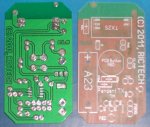Dicky Mint
Senior Member
Hi I'm an enthusiastic PCB designer and builder using the 'Sprint Layout' software.
I would like to gain some experience in designing and building single and double sided PCBs.
I have the intention of eventually making a modest profit but at first I am looking to gain some experience by fabricating boards for cost.
I don't know if there is any call here for bespoke PCBs from circuit diagrams or even first concept prototypes but you don't know 'till you ask!
My perspective is that I enjoy coming up with prototypes of electronic solutions to engineering problems and would like, one day, to make a modest living in this area.
Rick
I would like to gain some experience in designing and building single and double sided PCBs.
I have the intention of eventually making a modest profit but at first I am looking to gain some experience by fabricating boards for cost.
I don't know if there is any call here for bespoke PCBs from circuit diagrams or even first concept prototypes but you don't know 'till you ask!
My perspective is that I enjoy coming up with prototypes of electronic solutions to engineering problems and would like, one day, to make a modest living in this area.
Rick



